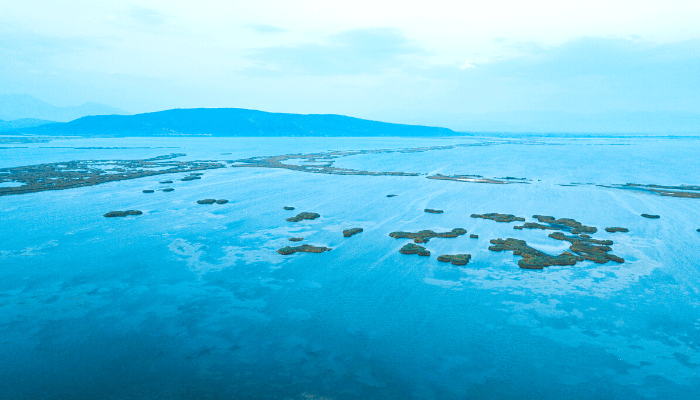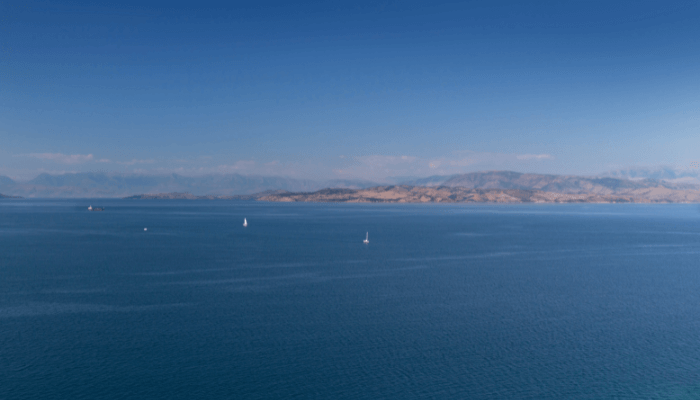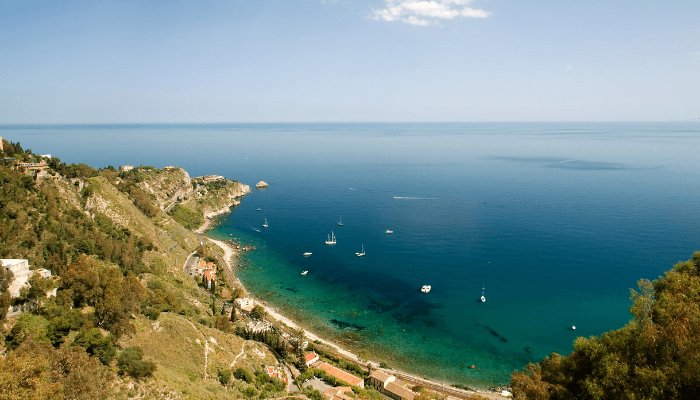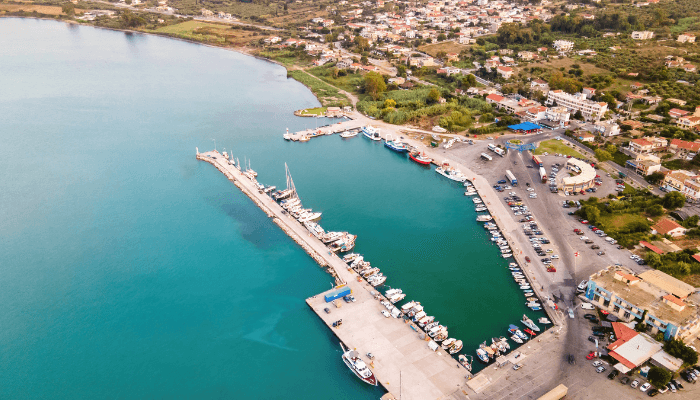10 Major Ionian Sea Facts You Must Know
The Ionian Sea is an elongated embayment of the Mediterranean Sea. It lies to the south of the Adriatic Sea and is surrounded by southern Italy, the coastline of Calabria, Sicily, and the Salento peninsula towards the west. From the northern side, it is bounded by the south portion of Albania, western Apulia, and the west coast of Greece, along with Peloponnese.
It was once considered a part of the Adriatic Sea by ancient writers; however, it is now seen as a different water body. Otranto Strait connects it to the Adriatic Sea, while Messina Strait links it to the Tyrrhenian Sea.
The Ionian Sea is fascinating in many aspects. Mentioned below are the 10 astonishing facts about the Ionian Sea.
Derives its name from ancient Greek legends
The term Ionian is derived from the Greek word Ἰόνιον, whose etymology is not known. However, ancient Greek authors like Aeschylus associated it with the legend of the god Lo. Hence, the adjective Ionios was utilized as an epithet for the seas and oceans because Lo swam across the stormy waters.
Oxford Dictionary suggests that the name may be taken from the Ionians, a group of seafaring communities who sailed to the west. Greek mythology is full of narratives about legendary figures and myths regarding the naming of the Ionian Sea. According to one version, Ionius was the beloved son of God Adrias, eponymic for the Adriatic Sea.

Another legend states that Ionius was the son of Dyrrhachus, who was betrayed by his brothers. God Heracles came to his help but killed Ionius by mistake. His body was laid to rest in the sea, which was then called the Ionian Sea, in his honor.
Formed during the Mesozoic Period, 252-60 Million years ago
As per research, the seabed of the Mediterranean Sea is made of old Mesozoic basins, the remaining relicts of Tethys ocean, and the relatively recent back-arc basins spanning the Neogene times. The Ionian Basin is one of the Tethyan remains. It is 351 kilometers wide and 600 kilometers long, with a three to four-kilometer water depth.
The basin lies amidst the continental platforms of North Africa, the Malta-Hyblean plateau, Calabria Arc, and the Hellenides. Numerous seismic studies conducted on the Ionian seafloor since the 1970s have concluded the presence of a very thin crust, ranging from 11 to 17 km, including a thick sedimentary pile.
However, recent findings have been unequivocal regarding the character of the crust. Though geophysical evidence points toward an old oceanic basin, experts are divided on its nature. Some support the oceanic origins of the seabed, while others favor a continental origin of the Ionian crust. More substantial evidence in the future might solve this enigma.
Ambracian Gulf is one of the largest gulfs of the Ionian Sea
Many gulfs and straits are found in the Ionian Sea. Ambracian Gulf, also known as Gulf of Arta or Actium and even Amvrakikos Gulf, is the largest gulf of the Ionian Sea. It lies in northwestern Greece and is 40 km long and 15 km broad. The towns of Preveza, Vonitsa, and Amphilochia lie on its coast.
It is shallow and is surrounded by marshes at its northern entrance. Rivers Arta and Louros flow into the water body, making it warmer and less salty than the Ionian sea. Its waters are abundant with grey mullet, sole, eels, and a local variety of shrimp. Many seabirds can be sighted in the lagoons, including majestic dolphins and sea turtles.

Other gulfs include Squillace, Taranto, Patras, Corinth, Laconian, Messinian, Augusta, Catania and Kyparissia Gulf.
Kefalonia is the largest among all the Ionian Islands
All the major islands of the Ionian Sea are situated in the eastern part of the sea and administered by Greece. They occupy a combined land area of 2307 square kilometers and include the island of Cythera, Ithaca, Zakynthos, Paxos, and Kefalonia.
Kefalonia is the largest island located in western Greece. It is the 6th largest island in Greece and a separate regional entity of the Ionian Islands region. Also known as Cephalonia, its capital city is Argostoli.
The island of Kefalonia covers 773 square kilometers and lies at the heart of the earthquake zone. Numerous minor tremors occur every year. The last major earthquake was recorded in 1953. It destroyed all the settlements on the island except Fiskardo in the north.
Corfu is a small greek island known for its rich cultural heritage and traditions dating back to Greek civilization. It was the site of ancient battles and medieval wars. It was one of the bulwarks that successfully repealed Ottoman conquest attempts and remained one of the most fortified settlements in the 18th century.
The island of Ithaca is identified with Homer’s Ithaca, the home of Odysseus, the protagonist of his famous work Odyssey.
Experiences a warm and wet climate
Given its geographical position, the Ionian Sea experiences a Mediterranean climate with hot and sunny summers and mild, rainy winters. The Ionian islands are outside the reach of Meltemi, dry north-westerly winds that blow during summers in the eastern Mediterranean. However, it still gets hot in summer, with maximum temperatures reaching 35 to 36 degrees celsius and even up to 40 degrees celsius. Clear skies and bright sunshine are characteristics of the spring season which lasts for a month.
Some days can be chilly in winters when the cold wind blows from the north, although extreme cold weather is rare. It hardly snows or freezes; however, snowfall occurs in the islands’ interior regions, on hills and mountains.

Rainfall is abundant, especially from October to March, and usually exceeds 800 millimeters annually. This is because the islands are exposed to the southern and western winds. It does not rain in summers as generally expected in Mediterranean regions.
The water temperature close to the Ionian islands is high from July to September, making it perfect for swimming, scuba diving, and snorkeling. In June, the weather becomes pleasant as temperatures reach 22 to 24 degrees celsius.
The best time to visit the islands is from June to August, as summer lasts longer in the southern islands of Cephalonia, Zakynthos, and Kythira.
The Deepest Point of the Mediterranean Sea lies in the Ionian Sea
Calypso Deep is the deepest point of the Mediterranean sea, situated in the Ionian Sea with a depth of 17,280 ft or 5267 m. It is located in the Hellenic trench, about 62.6 kilometers southwest of Pylos in Greece.
The first manned descent into the Calypso Deep was recorded on 27th September 1965. Three seamen, namely Captain Gérard Huet de Froberville, Charles L. Drake, and Henri Germain Deleuze, reached a maximum depth of 5110 m or 16,770 ft in their French Bathyscaphe Archimede.
Another mission was sent to the deepest part of the sea in January 2020, with Caladan Oceanic and DSV Limiting Factor, controlled by Victor Vescovo. The first dive was to the French submarine Minerve while the other crew turned to Calypso Deep.
Prince Albert II of Monaco and Victor Vescovo reached the Calypso Deep bottom, at a depth of 5109 or 16762 ft. This expedition confirmed that the 1965 French mission had reached the deepest point of the Mediterranean.
Lined with numerous commercial ports and harbors
More than 10 important ports are located on the Ionian Sea coastline. On the western coast are the facilities of Syracuse, Messina, and Catania. The northern coast is dotted with Taranto, Saranda, and Himara. Ports of Kerkyra, Parga, Preveza, Patra, Pylos, Igoumenitsa, and Astakos are positioned on the eastern shores of the Ionian Sea.
Messina is a key Ionian Sea Port located in northeast Sicily. It can handle general and bulk cargo along with cruises, cars, rails, ferries, and passengers. Its principal exports include fruits, wine, sulfur, and silk. More than 8,000,000 tonnes of cargo and over 300,000 passengers are handled at the port annually.

Preveza is close to the Amvrakikos Gulf in western Greece. It has four wharves with average depths of 13.0m. It handles a variety of items, including soya, timber, animal feed, fertilizers, oils, corn, iron, etc. A fishing berth adjacent to the main port can easily accommodate over 50 vessels. It also has a marina with 120 berthing facilities. More than 210 vessels frequent the port each year.
The biggest eastern port of Italy, Catania, has an S-shaped pier divided into the old and the new port with a berthing length of 3650 m and 17 berths. It deals with cruise ships, RORO Carriers, commercial vessels carrying wood, cereals, coal, fertilizers, iron products, etc. Around 4,350,000 tonnes of cargo and 18,000 TEU are handled at the port annually.
Site of numerous battles and ancient Shipwrecks
Many naval battles and skirmishes took place in the Ionian Sea between the civilizations of Greece and Rome. One such famous battle is the war of Actium, fought between Marc Antony and Octavian in 31 BCE.
The Ionian Sea is also rich in shipwrecks dating back to the ancient period till the 20th century. Many world war battleships, sailing boats, and commercial ships of kings and pirates lay at the depths of the Ionian Sea. Around 11 out of 36 known shipwrecks in the region have been studied through marine remote sensing and ground truthing methods.
Additionally, many interesting discoveries have been made in the recent past. For instance, in 2020, a Roman cargo ship containing amphorae was discovered by marine archaeologists from Patras University. The Fiscardo shipwreck is situated near the northeastern end of Kefallinia island, around two kilometers from Fiskardo bay.
The Ionian Sea is rich in white sea corals
Like the Mediterranean Sea, the Ionian Sea is also rich in coral populations, especially the white sea coral, which is most prominent in its waters. White sea coral species of Lophelia pertusa and Madrepora oculata are found in abundance. Other living coral species include the solitary Desmophyllum crista Galli and Stenocyathus vermiformis.
According to research, more than 50 species of macroscopic flora are found in the Ionian Sea. The water body is filled with fish caught for food, such as Tuna, Mackerel, Bonito, sea bream, Mullet, swordfish, whales, sharks, seals, crabs, and shrimp. However, overfishing and plastic pollution are significant problems faced by the Ionian Sea.
A major holiday destination
Ionian sea hosts many attractive beaches, resorts, and travel destinations that can leave one mesmerized. White sandy beaches, olive groves, and forests overlooking the sea are perfect for a relaxing vacation. One such place is Myrtos beach and Navagio beach.
One of the most visited destinations on the coast is the greek village of Paleokastritsa. It is said to be the place where Odysseus was washed ashore and met his lover Nausicaa in Homer’s Odyssey. A quiet place, it is mostly visited by lovers and newlywed couples.
You might also like to read
Disclaimer :
The information contained in this website is for general information purposes only. While we endeavour to keep the information up to date and correct, we make no representations or warranties of any kind, express or implied, about the completeness, accuracy, reliability, suitability or availability with respect to the website or the information, products, services, or related graphics contained on the website for any purpose. Any reliance you place on such information is therefore strictly at your own risk.
In no event will we be liable for any loss or damage including without limitation, indirect or consequential loss or damage, or any loss or damage whatsoever arising from loss of data or profits arising out of, or in connection with, the use of this website.
Do you have info to share with us ? Suggest a correction
Disclaimer :
The information contained in this website is for general information purposes only. While we endeavour to keep the information up to date and correct, we make no representations or warranties of any kind, express or implied, about the completeness, accuracy, reliability, suitability or availability with respect to the website or the information, products, services, or related graphics contained on the website for any purpose. Any reliance you place on such information is therefore strictly at your own risk.
In no event will we be liable for any loss or damage including without limitation, indirect or consequential loss or damage, or any loss or damage whatsoever arising from loss of data or profits arising out of, or in connection with, the use of this website.

About Author
Zahra is an alumna of Miranda House, University of Delhi. She is an avid writer, possessing immaculate research and editing skills. Author of several academic papers, she has also worked as a freelance writer, producing many technical, creative and marketing pieces. A true aesthete at heart, she loves books a little more than anything else.
Latest Maritime Knowledge Articles You Would Like:
Subscribe To Our Newsletters
By subscribing, you agree to our Privacy Policy and may receive occasional deal communications; you can unsubscribe anytime.















